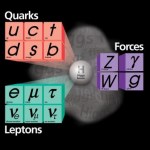Science
Over in Twitterland, we have a question from WillyB:
If you had to pick one topic to cover in Physics, which do you think is the most important for the gen. public?
This sounds like a job for the Internet! To the polling machine!
If you had to pick one topic to cover in Physics, which do you think is the most important for the general public?
While several of the options allow linear superpositions of solutions, this is a purely classical poll, so you may choose only one answer. Though you should, of course, feel free to bitch about the choices in the comments.
While reading bits of Neil deGrasse Tyson's Space Chronicles yesterday, I ran across this quote, attributed to "an Assyrian clay tablet from 2800 BC":
Our Earth is degenerate in these later days; there are signs that the world is speedily coming to an end; bribery and corruption are common; children no longer obey their parents; every man wants to write a book and the end of the world is evidently approaching.
This made me scratch my head for a couple of reasons. I've seen this quote before, but always attributed to Cicero, which sorta-kinda makes sense. Seeing it moved back in time by a few…
"...the publisher wouldn't let us call it the Goddamn Particle, though that might be a more appropriate title, given its villainous nature and the expense it is causing."
-Leon Lederman, author of The God Particle
The Higgs Boson: you know the deal. It's the last undiscovered particle in our current picture of all the fundamental particles in the Universe.
Image credit: Fermilab, retrieved from eurekalert.org.
If we can find it, we'll either have a big clue as to what the next step to take in physics will be, or we'll be forced to admit that physics works too well, and many of the great…
The Kavli Science Video Contest has wrapped up with over 260 entries! Now its time for the People's Choice Vote, in advance of the awards ceremony on April 29, in Washington, DC, as part of the USA Science & Engineering Festival. People's Choice Voting begins April 2 and closes April 13. Voting is easy, just view the videos on YouTube and click 'like" for your favorites. Click here to view the videos.
We will be highlighting the Top 20 Finalists on our blog for the next two weeks. In today's blog get to know the first five of the top 20 Finalists:
SPOTLIGHT ON KAVLI VIDEO CONTEST:…
So, the infamous OPERA result for neutrino speeds seems to be conclusively disproven, traced to a problem with a timing signal. Matt Strassler has a very nice explanation of the test that shows that the whole thing can almost certainly be traced to a timing error that cropped up in 2008. This problem is generally described as resulting from a "loose fiber optic cable," and Matthew Francis's reaction is fairly typical
The main culprit was a fiber optic cable that was slightly out of alignment. This is not quite a "loose wire", as it sometimes has been described: it's far more subtle and harder…
By Larry Bock
Founder and organizer, USA Science & Engineering Festival
The world runs on science and math, but let's face it, to get this across effectively to young students we sometimes have to get a little, well... messy.
No one knows this better than math and science author Sean Connolly who's gained a reputation with kids and teachers alike for breathing life into such potentially stuffy scientific tenets as Boyle's Law and Bernoulli's Principle through hands-on demonstrations and experiments that involve everything from potato guns and cola geysers to film-canister rockets and…
In comments to yesterday's post, Andrew G asked:
Speaking of writing, is there an errata list somewhere for "How to teach relativity to your dog"?
No, but there probably should be. I believe there's an error in one of Maxwell's equations (an incorrect sign, though you should've seen the first typeset version...), but given the length and complexity of the book, there are almost certainly other mistakes. So, if you've spotted an error, in physics, grammar, or anything else, leave a comment here, and I'll compile a list of things to fix if we ever get the chance.
Steve Hsu has a post comparing his hand-drawn diagrams to computer-generated ones that a journal asked for instead:
He's got a pretty decent case that the hand-drawn versions are better. Though a bit more work with the graphics software could make the computer ones better.
This reminded me, though, of something I've always found interesting about scientific publishing, namely the evolution in the use of figures through the years. Whenever I need to do literature searching, I always suspect you could guess the approximate date of a paper's publication by looking at the figures.
If you go back…
I was thinking about attitudes toward physics the other day, and realized that whenever I meet somebody (not a physicist) for the first time and tell them that I'm a physicist, their initial responses most frequently fall into one of three general categories:
"You must be really smart."
"I hated that when I took it in high school/ college."
"Can you explain string theory to me?"
It occurs to me that this helps explain why physicists are not generally considered scintillating conversationalists. Because, really, where can you go from any of those starting points?
Anyway, that got me…
Once upon a time, there were three giant hippopotamuses...
No, Daddy, it was three little pigs.
This is a completely different story, honey.
Once upon a time, there were three giant hippopotamuses, who lived together in a river in Africa.
They lived in a house.
Well, hippos spend most of their time in the water, so they really lived in the river.
But they had a house on the bank of the river, which was very nice.
OK.
And one day, something happened, which was...?
A big bad wolf came to their house!
No, honey, hippos live in Africa. They don't have big bad wolves in Africa.
Oh. Ummm... A…
The title says it all: an animated video of Heisenberg singing about the Uncertainty Principle:
So, you know, there's that. It's pretty good, but he's no Feynman:
And that's your silly musical break for the day.
Richard Feyman famously once said that the double-slit experiment done with electrons contains everything that's "'at the heart of quantum physics." It shows both particle and wave character very clearly: the individual electrons are detected one at a time, like particles, but the result of a huge number of detections clearly traces out an interference pattern, which is unambiguously a wave phenomenon. The experiment has been done lots of times, but a particularly nice realization of it comes from Hitachi's R&D department, where you can see both still images and video of their experiment…
I had a signing yesterday at the Barnes & Noble in Vestal, NY, which drew a smallish crowd mostly of friends and family. SteelyKid came, of course, and while she spent most of her time bopping about other parts of the store, she came over to the signing area while I was signing books for people after reading a bit. They had a big stack of copies of How to Teach Relativity to Your Dog, and she started picking them up and handing them to me.
"No, honey," I said, "Those are for other people. Give them to somebody else." So she happily ran one over to my mother. And then to one of my aunts.…
So, the previous post poses a physics question based on some previous fooling around with modeling my commute:
A car starts from rest at the beginning of a straight 1km course, accelerates up to some speed, cruises at constant speed for a while, then decelerates to a stop at the end of the course. A second, identical car does the same course, but decelerates to a stop at the halfway point. It then immediately accelerates back to its cruising speed, and then decelerates to a stop at the end of the course.
How much faster does the second car have to go in order to complete the course in the…
Back in the summer, I did a post mathematically comparing two routes to campus, one with a small number of traffic lights, the other with a larger number of stop signs, and looked at which would be faster. Later on, I did the experiment, too.) Having spent a bunch of time on this, I was thinking about whether I could use this as a problem for the intro physics class. I decided against it last fall, but something else reminded me of this, and I started poking at it again.
So, I played around a bit with some numbers, and came up with the following possible framing for a question. I'll throw…
The quick publicity items for this weekend:
1) I will be on the Science Fantastic radio show either Saturday or Sunday, depending on when your local affiliate runs it (or when you choose to livestream it over the Internet). The interview has already been recorded, which leaves me free for:
2) I will be signing and possibly reading from the new book at the Barnes and Noble store in Vestal, NY at 2pm on Saturday. If you're fortunate enough to live in the Southern Tier, stop by and say hi.
"Hey, dude," the dog says, looking concerned. "We need to talk."
"Yeah? What's up?"
"Look, it's great that you're transcribing the human puppy's stories into Twitter and all, but I'm feeling left out. I've got my own Twitter account and all, but you hardly ever type any of my tweets any more. I have to do it myself, and it's hard to be witty when you have to type with your nose."
"I'm sorry. Is there something specific you'd like to tweet about?"
"Well, yeah," she says, in a tone like I've said something stupid. "I mean, obviously, we have a new book about relativity. And look at this…
The news was just publicly announced that the University of Maryland is now the 2nd hospital to perform full face transplant in the US. Just a handful of these procedures have been performed around the world, and they are enormously complex ethically, surgically and medically.
To begin with, long before the surgery even became a possibility, there have been years of work put into setting up such a novel transplant program. Besides obtaining approval for what is still an experimental procedure from an IRB, it is necessary to very carefully screen a population of potential recipients. A face…
It's been a while since I did any ResearchBlogging posts, because it turns out that having an infant and a toddler really cuts into your blogging time. Who knew? I keep meaning to get back to it, though, and there was a flurry of excitement the other day about a Nature Physics paper proposing a way to search for quantum gravity not with a billion-dollar accelerator, but with a tabletop experiment. There's a write-up at Ars Technica, but that comes at it mostly from the quantum gravity side, which leaves room for a little Q&A from the quantum optics side.
Wait a minute, you said this is in…
So, this is the new book from the authors of Why Does E=mc2?, covering quantum mechanics in a roughly similar manner. This book, or, rather, Brian Cox talking about some material from this book, created a bit of controversy recently, as previously discussed. But other than that, Mrs. Lincoln, how did you like the play?
The big hook here is that they set out to discuss quantum mechanics for a popular audience using a Feynman-type picture from the very beginning. This is an intriguing idea, and sort of appealing in the same basic way that Sakurai's famous graduate text in quantum mechanics and…

